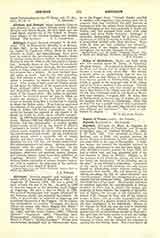

Aichinger, GREGOR, organist and composer of sacred music, b. probably at Ratisbon in 1565; d. at Augsburg, January 21, 1628. He was a priest at least towards the end of his life. As early as 1590 he was the organist to the patrician Jacob Fugger at Augsburg. He paid a visit to Rome in 1599. His musical development was largely influenced by the Venetian school, and especially by Gabrieli. In 1601, or thereabouts, he returned to Augsburg and reentered the service of the Fuggers. Of his numerous compositions we mention “Liturgica, sive Sacra Officia ad omnes dies festos Magnae Dei Matris” (Augsburg, 1603); “Sacrae Cantiones”, for four, five, six, eight, and ten voices (Venice, 1590); “Trieinia Mariana” (Innsbruck, 1598); “Fasciculus Sacr. Harmoniarum” (Dillingen, 1606). The full list is found in Eitner’s “Quellen-Lexikon.” Proske thus characterizes Aichinger and his fellow-worker Hassler in the Fugger choir: “Though Hassler excelled in intellect and originality, both masters had this in common that they combined the solid features of German art with the refined forms of Italian genius, which flourished at that time especially in Rome and Venice, and had stamped their works with freer melody and more fluent harmony. Aichinger in particular distinguishes himself by a warmth and tenderness of feeling bordering on mellowness, which is everywhere imbued with deep devotion. Meanwhile he does not lack sublimity nor solemnity, indeed some of his longest compositions satisfy throughout the strictest demands of art.”
J. A. VOLKER

